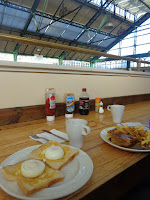Another reason we opted for the southwestern spit of England was to get within spitting distance of Cornwall. After exploring the moors for a day, we headed west toward the region known for its craggy coastline. Most people aim for Lands End, the country's most southwesterly point, or Lizard Point, its most southerly point, but we were content to experience some harbors off the beaten path. TJ steered us toward Porthleven, the country's most southerly port (left). Its harbor was constructed in the early 19th century in response to the shipwreck of the HMS Anson, whose recovered cannon sits on the protective walls (right).
The fishing town was already decked out for the holidays. We were a little early for its boat light parade (top left), but we saw a little doggie full of Christmas cheer strutting its stuff in one of the downtown shops (top right). It was tight quarters at The Ship Inn, with little room for Sage (bottom), so instead of drinking with the local fisherman, we angled for a spot outside, overlooking the harbor.
Next, we headed inland to Helston, once a river port but now a market town since the waterway silted up. In the past the city was home to 30 ale houses that brewed their own beer, and TJ wanted to visit the oldest one remaining: The Blue Anchor (top left). The inn was once a monk's rest that brewed mead, but now its on-site Spingo Ales Brewery creates four types of ale, all of which are served as blends (top right). The bar is also known for its skittles alley and outdoor music venue, but I personally was drawn more to its cozy interior rooms (bottom).
Just in time for sunset, we skirted the Lizard Heritage Coast until we reached St. Michael's Mount, the site of a church, castle, harbor, and village, all dating from various times (top left). When the tide is low, the outcropping can be reached by walking on a causeway from Marazion, believed to be the oldest town in Great Britain. During high tide, the isle, managed and occupied by the St. Aubyn family, is accessed via a car-boat (top right). By the time we made it to Penzance, the sun was fully faded, and we were ready for a meal (bottom).The options in Penzance were numerous, but since it worked the previous night, we took the advice of a barman and set out to find some place to eat in Port Isaac, a well-hidden harbor turned holiday village (top). Its cluster of historical buildings makes it a frequent set for film and TV, including the popular period drama series Poldark (bottom left). It happened to be fish and chips Friday at The Slipway, so TJ and I both had the daily special then headed back to our accommodations.
The next morning, we checked out relatively early, so we could make some stops on our way back to London. In bustling Exeter, we grabbed breakfast near Catherine Square, where ruins of an eponymous church remain (left). The city's more famous religious building is Exeter Cathedral, whose claim to fame in the architecture world is having the longest vaulted ceiling in England. Judging from the crowd, it's likely more well-known among laypeople for its annual Christmas Market (right).
Next and last up was Bristol, whose alternative vibe is clearly on display through its abundance of public street art, much of which is created or inspired by native Banksy (top). The mix of history and hipster is also center stage at St. Nicholas Markets (bottom left). Because it was late in the day, most of the food shacks were shuttered, but we managed to get a snack from Pieminister, a UK-wide phenomenon that started in Bristol (bottom right).
Being so close to Wales, Bristol shares some affinity with its capital, as illustrated by the existence of a second Small Bar franchise, which was more spacious and less crowded than its Cardiff counterpart. One local concept I'd like to see go global is The Apple, a converted Dutch barge that serves only cider pints and cheesy fries (left). Luckily, the boat was well-tethered to the banks of the River Avon, so Sage didn't have any problem adjusting to his sealegs (right).


































































